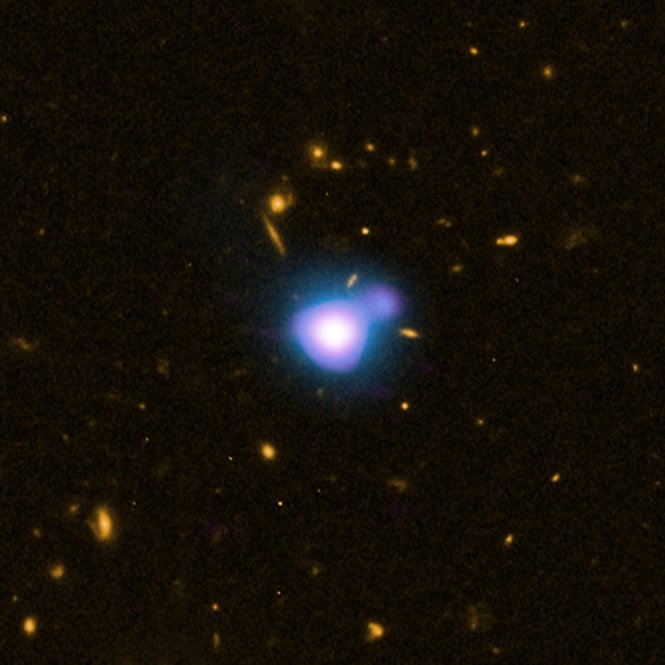
 Credit: X-ray (in blue): NASA/CXC/NRC/C.Cheung et al; Optical (in yellow): NASA/STScI; Radio (in purple): NSF/NRAO/VLA
Credit: X-ray (in blue): NASA/CXC/NRC/C.Cheung et al; Optical (in yellow): NASA/STScI; Radio (in purple): NSF/NRAO/VLA
Giant Jet
The image above shows a composite X-ray, radio and optical image of an ancient quasar known as GB 1428+4217, located at a distance of 12.4 billion light-years from earth. Quasars are galaxies with incredibly bright central regions, so bright that the central region outshines all the rest of the galaxy. The galactic nucleus is powered by a supermassive black hole which is rapidly accreting matter from the galaxy. As this accreted matter death-spirals into the black hole's event horizon, never to be seen again, it heats up and generates tremendous amounts of radiation. Some of this material is lucky enough to escape the ravenous maw of the black hole, and streams outward from the black hole in the form of a narrow jet of radiation and high-energy subatomic particles, some 230,000 light years long, larger than the entire Milky Way. Observations of the X-ray emission by the Chandra X-ray Observatory and in the radio by the Very Large Array show that both the central galaxy and the jet (seen extending to the upper right of the center of GB 1428+4217) are bright sources of X-rays and radio radiation. Astronomers believe that the X-ray emission from the jet is actually due to photons from the Big Bang colliding with high-energy electrons trapped in the jet.
Published: December 3, 2012
<
HEA Dictionary ● Archive
● Search HEAPOW
● Other Languages
● HEAPOW on Facebook
● Download all Images
● Education ● HEAD
>

Each week the HEASARC
brings you new, exciting and beautiful images from X-ray and Gamma ray
astronomy. Check back each week and be sure to check out the HEAPOW archive!
Page Author: Dr. Michael F. Corcoran
Last modified Monday, 26-Feb-2024 17:10:28 EST


